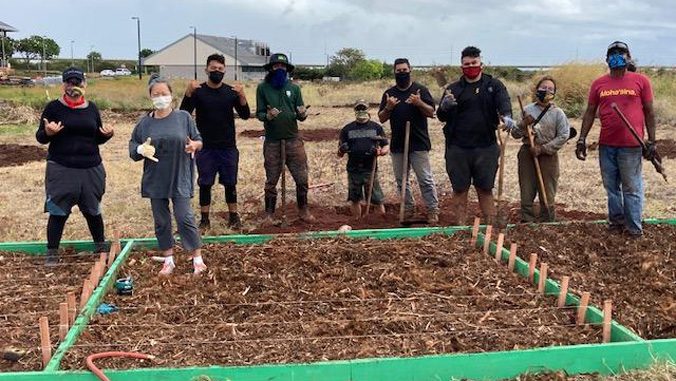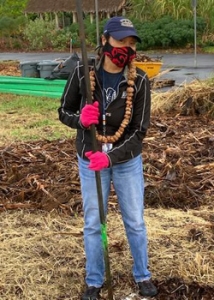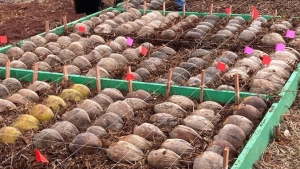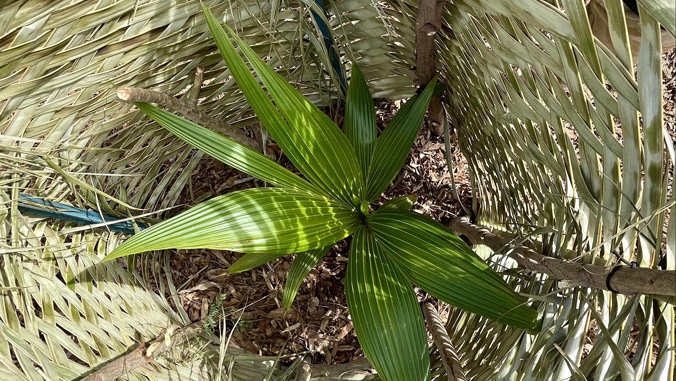
The Uluniu Project—an effort to engage in the practices of food security, cultural dissemination of knowledge, and the growing of student leadership through aloha ʻāina work—is expanding at the University of Hawaiʻi–West Oʻahu with the recent placement of 264 niu (coconut) seedlings in its Niu Nursery.
Preparations have also begun for the first ʻulu (breadfruit) and niu plantings in its Uluniu Grove after the digging of 20 ditches for their placement.
The project was established by Indrajit Gunasekara, a UH West Oʻahu financial aid officer, and Manulani Aluli Meyer, the Konohiki of Kūlana o Kapolei.
“We are living in mythic times,” Meyer said. “The Uluniu Project is about responding to the kāhea, the call. We are answering a call for relationship with land and thus to awaken to ways we can feed ourselves from the food of this relationship. Growing ʻ/breadfruit and niu/coconut is one such response that will give us both—food and relationality.”

First seeds
Since its inception in 2017, the project has grown with workshops reaching hundreds of community members and college students via presentations on campus, and at local and statewide conferences, schools, farms and many educational sites on the purpose and need for food-producing trees—specifically ʻulu and niu.
The Uluniu Project team has gathered a community of scholars and Indigenous practitioners to connect and strengthen cultural practices with science-based applications to highlight ʻulu and niu potential within the Hawaiian islands. The Uluniu Project goals include Hawaiian cultural revitalization, environmental conservation and local food production.
Documenting diversity
With the establishment of the Niu Nursery, the goal is to document and germinate a collection of seed coconuts with special focus on Oceania dwarf (niuliʻi) and local niu varieties found in the ahupuaʻa of Honouliuli. There are currently 24 different morphologically documented varieties in the nursery.

One purpose of the nursery is to produce meaningful gifts that highlight the university’s Pahuhopu/Institutional Values: Mālama ʻĀina, Kaiāulu, Waiwai and Hana Lawelawe; along with the activation of two key elements of its Theory of Distinctiveness: Sustainability and Innovation.
Other purposes are to acknowledge and document local niu diversity on the Leeward Coast through research and educational materials, and to promote a local and international coconut gene banking protocol to ensure the perpetuation of Hawaiian niu diversity. Gunasekara is currently working with Noa Lincoln of UH Mānoa to further understanding of Hawaiʻi’s niu diversity.
Student opportunities
The nursery and grove will also help to promote and provide quality space for UH Systemwide students’ research projects on sustainability, soil rejuvenation and local food production; and connect with scientific community members and others interested in these topics.
The Uluniu Project welcomes a limited number of volunteers for its work days—8 to 11 a.m. most Saturdays—to assist with tasks such as amending soil, clearing the grove area, and planting native plants to surround the area and protect the moisture.
Volunteers must sign liability waiver forms and follow COVID-19 guidelines. Those interested in volunteering may contact Aloha ʻĀina Student Service Club President Jesse Mikasobe-Kealiinohomoku at jmk23@hawaii.edu or Aloha ʻĀina Student Service Club Advisor and Uluniu Project Coordinator Gunasekara at indrajit@hawaii.edu for more information.
Read more at Ka Puna O Kaloʻi.
—By Zenaida Serrano Arvman


